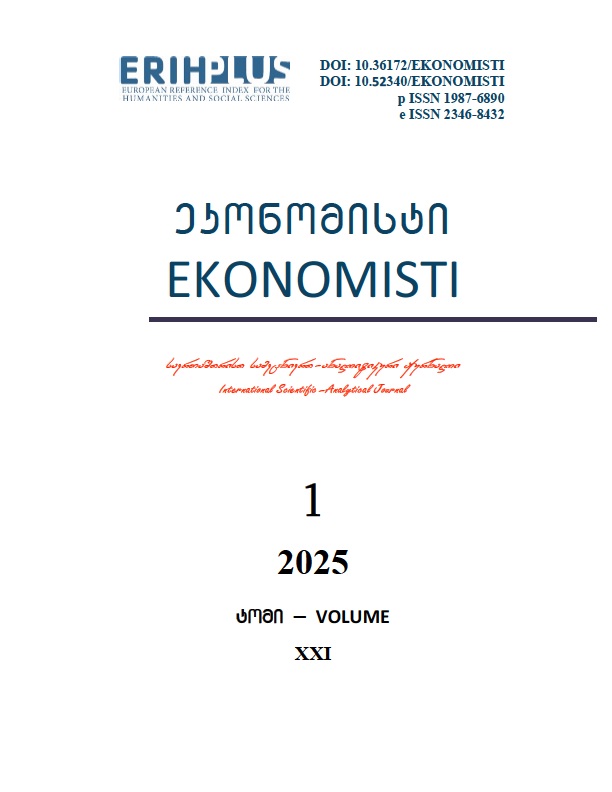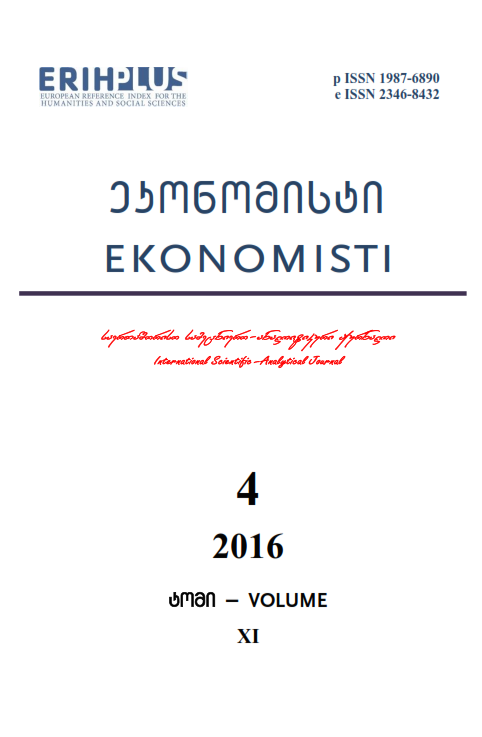
The international scientific and analytical, reviewed, printing and electronic journal of Paata Gugushvili Institute of Economics of Ivane Javakhishvili Tbilisi State University

Theoretical-methodological foundations of social-economic security and anti-crisis management of the healthcare system
Expanded Summary
Anti-crisis management, as an organization's management system, has a complex systemic nature. It aims to prevent or eliminate undesirable events for business by using the full potential of modern management, which means that a special program for the organization must be developed, which will have a strategic character and allow us to overcome temporary difficulties, maintain and increase our market positions under any conditions.
The concept of anti-crisis management is one of the controversial ones in scientific literature, there are different points of view about its definition and content. Etymologically, "anti-crisis" means the opposite side of the crisis, which is directed against the crisis (from the Greek anti - "opposite", crisis - "border between two states, turning point"; "decision").
For crisis management, we can choose goals, the combination of which ultimately represents anti-crisis management:
• Anticipation of a crisis and adequate preparation for it (means in accordance with the degree of danger)
• Prevention of dangerous crisis factors
• Managing the dynamics of crisis development (acceleration, slowing down, softening, strengthening)
• Ensuring vital activities of the organization in a crisis situation.
• Weakening of the negative effects of the crisis.
• Use of crisis factors and results for further development of the organization.
Types of crisis in terms of levels, are:
- crisis of enterprises, firms, companies (for example, due to incorrect or irrational credit or commodity policy of the firm);
- the crisis of industries (for example, in some countries, the raw materials industry had and has the potential for development, but it is not high-tech, because the supply of high-tech goods on the world market is sufficient);
- crisis of regions (for example, due to various objective reasons of the country, subsidies should be provided more than others, therefore, economic support of strong regions is needed, which is limited and not profitable for the latter);
- the economic crisis at the state level is largely associated with endogenous, i.e. internal factors (for example, due to a high level of corruption in the country or a large and unregulated differentiation of salaries);
- The economic crisis at the state level is mostly associated with exogenous, i.e. external factors.
The classical crisis cycle is characterized by four phases - 1) recession (recession); 2) lower (depression); 3) rise (revival); 4) The peak (beginning of the cycle) and the periods of existence of these phases may differ, depending on the specifics of the crisis.
Detection of the threat of crisis, timely capture of signals indicating a possible deterioration of the object's position, its competitive status. The same influence of external factors affects the state of objects in different ways due to the peculiarities of the internal environment and connections with the external environment.
According to the stages of development of the crisis process, anti-crisis management can be divided into: early (on the basis of the stable state of the object), exit (in case of loss of competition, positions relative to other objects) and actual management of the crisis (mitigation, exit from it) through strategic and tactical management.
There are many articles and papers on crisis management. One of the interesting articles is authored by Jay Fuchs, where the author cites statistical data from various studies and explains why we should have a crisis management strategy developed.
According to Jay Fuchs: "You can't control the crises in your business, but you can control how you prepare and respond."
Realizing that the economy develops cyclically, it is necessary to take into account the double nature of the crisis - on the one hand, the destructive process of destruction, and at the same time - the possibility of renewal, on the other hand. In this case, we mean that the crisis not only creates problems, but also creates opportunities to reorganize the economy, to reveal its weaknesses, critical points, in other words, to correct the flaws that are not visible on the trajectory of the crisis - free development.
Problems related to socio-economic security of health care are diverse and reflect the complexity and ambiguity of their study, since in this field there is an overlap of theoretical problems with a number of practical difficulties.
A feature of economic security in the national security system is the fact that economic security provides the possibility of other types of national security, including: social, military, informational, technical, environmental, etc.
The state must be able to provide a level of security that ensures internal and external stability, which is necessary for the normal functioning of economic activity, the active participation of the country in the international distribution of labor and competitiveness. As a rule, the economic security of the state functions as a system, the main functions of which are divided into five groups: protective, regulatory, preventive, innovative and social.
Scientists Kim and Lau conducted research in 4 countries of the Pacific Ocean where reliable information was available on physical capital stocks. From a modeling point of view, the impact of health grows the rates of demand and the flexible approach to functional form emphasizes the form of the relationship including human capital, and the outcome.
An increase in spending and investment in the health sector undoubtedly creates a positive economic effect. This is both the creation of new jobs and the stimulation of the consumption of medical services due to their quality and availability, increasing the potential of human capital involved in all areas of the economy.
In order for the economic security structure of the healthcare system to be sound, it should include several components:
1) financial - solvency of medical organizations, liquidity of assets of medical organizations, optimal capital structure;
2) Personnel - creation of conditions and provision of medical organizations with highly qualified medical personnel, as well as creation of conditions for organization and provision of a system of education and qualification of medical personnel;
3) political and legal - legislative sphere to ensure the activity of medical organizations, for the functioning of medical organizations within the legislative sphere;
4) environmental protection - compliance with sanitary and epidemiological regulations, standards for working with biological and hazardous waste, strict compliance with legislation, optimization of financial costs in order to reduce financial losses;
5) Power - ensuring the safety of the property of medical organizations, creating a safety system for patients and personnel;
6) sanitary and epidemiological - providing safety conditions for the activity of the medical organization, the possibility of which does not exist.
In 2018, a forum was held in Tokyo to improve the efficiency of medical care and the health safety of patients. The main task of the forum was to raise awareness about the problem of patient safety. The adopted declaration, based on World Health Assembly resolution 55.18, calls for "the greatest possible attention to patient safety" and "to develop and strengthen evidence-based measures necessary to improve patient safety and health care, including drug monitoring, medical devices and technologies".
In the conditions of effective functioning of health care systems, formation of the structure of the concept of national, social and socio-economic security, their formal institutional, i.e. state, level and specific type is especially necessary. Also at this level goals can be distinguished: health improvement, health maintenance, diagnosis and treatment, where the main task will be contact with a specific patient.
S. Wlodarczyk notes the dualism of the health care system in terms of real and conceptual approaches. On the one hand, it is clearly defined, coherent and ordered as a part of a single social system of a specific state. From a conceptual point of view, the healthcare system is a schematic approximation of reality, its model.
Therefore, the scientist formulates the following definition of the healthcare system: "The system as a whole is a set of interconnected parts, that is, people, processes, products, services, which are related to one goal". At the same time, the following components of the system specific to the provision of medical services are necessary: its institutional principles; system objects (medical organizations); National specifics and norms of providing medical services generally accepted in society".
According to the recommendations provided by the World Health Organization, the health care system operates around three pillars of service delivery: health protection, disease prevention, and health promotion.
Finally, we can say that the object of the health care system is many aspects of the health of each person and society as a whole. It is a set of actions to maintain and promote health, as well as to address diseases, disabilities and other medical problems.
It is difficult to overestimate the importance of the concept of "economic security in the health care system". If we talk about economic security in the medical industry, it is directly related to the solvency of the population and the country's budget. For private medical organizations, a decrease in the level of solvency of the population leads to a decrease in financial stability. In the conditions of the economic crisis, only a small part of the population can receive the services of medical organizations, which has a negative effect on the development of this sector of the medical services market. Most of the population of the country has the opportunity to use the medical services provided by the health service only at the expense of the mandatory medical insurance and the budget. The lack of investment financing may lead to a decrease in the current level of public health. The analysis of the level of economic security of the health system allows us to identify possible directions for overcoming threats.
"Economic security of health care": this is the creation of conditions and factors for the development of medical organizations and the growth of the population in the region, the activity of the health care system, which is based on the development of the potential of the health care system (personnel, innovation, technology) and the protection of the system from direct and indirect organizational and economic threats.

